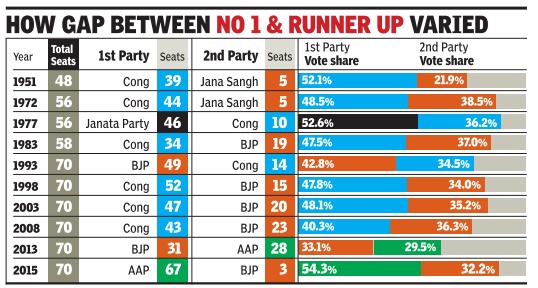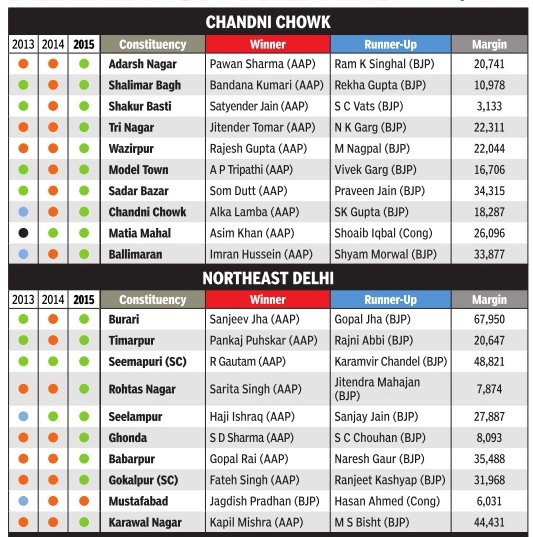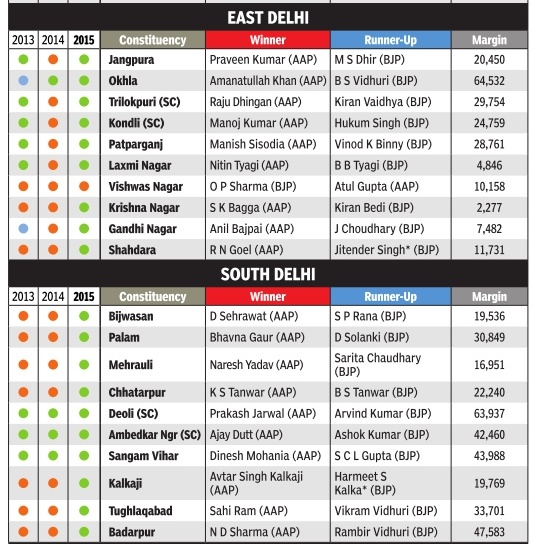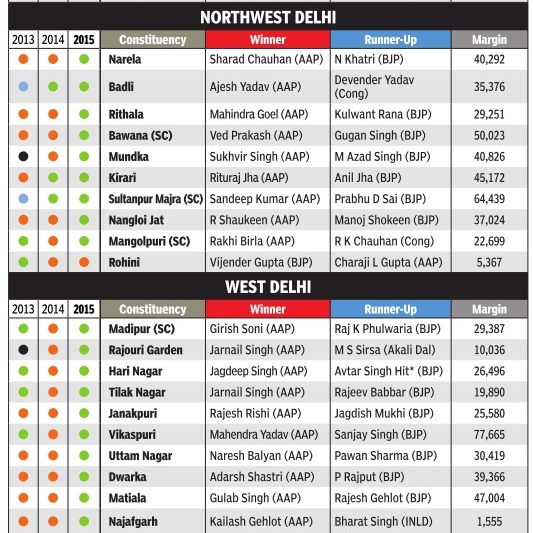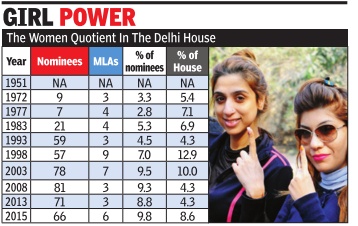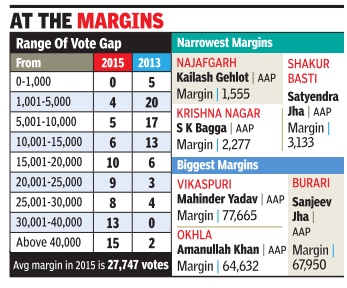Delhi: Assembly elections,2015
This is a collection of articles archived for the excellence of their content. |

Contents |
Aam Aadmi Party: a comeback
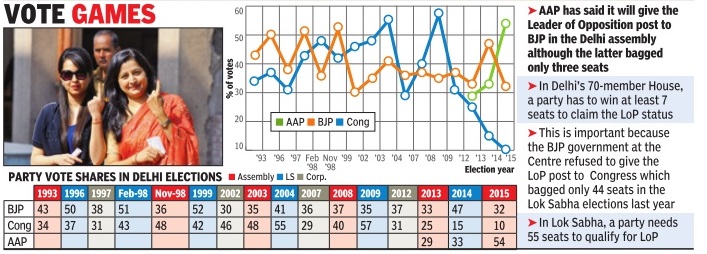
Feb 11 2015
Vibrant campaign connected with every caste, class
For the second time, Aam Aadmi Party has shown it does not need a long runway to take off, and what gives it lift is a massive army of dedicated workers that's always on the ground. In 2013, the party made a stellar electoral debut al though it was not in the race till September. This time also, it galvanized only in Decem ber. But after that it didn't lose focus although there was no certainty over election dates. While AAP's rallies and jan sabhas started formally on December 1, its teams had al ready started campaigning from door to door. The middle class seemed disenchanted with the party after the Lok Sabha polls, but mohalla sabhas by its 27 MLAs t to discuss the utiliza tion of funds helped it regain ground. Suresh Garg, a resident of Malviya Nagar, said people were im pressed by AAP's commit ment to `swaraj'. “ AAP had promised to hold such sabhas but we stopped taking it seri ously after its government re signed. However, regular con sultations by its MLAs restored our faith.“
AAP declared its 70 candi dates by the first week of Janu ary, so they campaigned hard for much longer. Some of its candidates were first-timers and the head start helped them become visible.
AAP's style of campaigning, marked by youthful energy, also made it stand out. A team of young, dynamic and extremely dedicated volunteers worked on creating a peppy theme song, creative advertisements and innovative campaigns like flash mobs. It also maintained a strong presence on social media.
On February 1, shoppers in Connaught Place were surprised to find hundreds of youngsters wearing the trademark AAP cap walking along Inner Circle, strumming guitars, singing patriotic songs and asking people to vote for `Mufflerman'. So effective was this style of campaigning that within minutes BJP sup porters started their own rally in CP. Public outreach through door-to-door cam paigning has always been an AAP strongpoint. Each candidate went on at least one round of their area. They did nukkad sabhas and showed documentaries about the party. An army of volunteers from other states and abroad that started arriving in December provided the extra thrust needed in the thick of campaigning.
While BJP and Congress relied on mega-rallies, AAP stuck to its VS-JS--vidhan sabha-jan sabha--model focused on small areas. It did on ly one big roadshow. “In the VS-JS model, our star campaigners and candidates address small groups in each constituency , ensuring that people from only that constituency attend the sabha. Arvind Kejriwal addressed 110 sabhas since December 1, 2014 and must have been heard by 7-8 lakh people,“ said Aashish Talwar, AAP's chief strategist.
While other parties dithered about releasing manifestos--BJP went to the polls without one--AAP consulted people to draft its promises through Delhi Dialogue, a series of discussions revolving around water, power, women's safety, swaraj, Jan Lokpal, education, health etc. It thus involved residents, policy makers and experts in looking for solutions to common problems. Decisions from the dialogues were merged to make the party manifesto and discussed threadbare during jan sabhas. This `positive agenda' marked a break from the politics of mudslinging that other parties employed to discredit Kejriwal. The party's social media team ensured its online presence never dipped. Very often, their hashtags trended for days. In one instance, volunteers decided to make Kejriwal's muffler a positive association and started the `Mufflerman' trend accompanied by eye-catching posters.
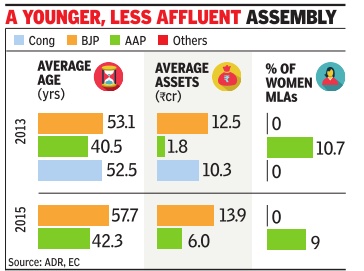
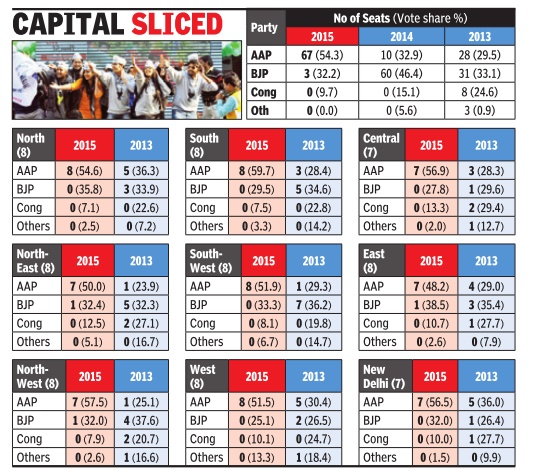
Feb 11 2015 Kejriwal and his team double their vote share
When a party raises its vote share from 29.5% to 54.3% from one election to the next, it cannot do so by improving in only some areas, but even so there are districts of Delhi where AAP's growth in the last 14 months has been more spectacular than in others. Its vote share in every district now is over 50% with the exception, ironically of the East district where it did so well last time. But even here, its share of 48% is nothing to sneeze at.
The truly stunning jumps have come in the South, North-West, North-East and Central districts. In each of these it has more than doubled its vote share from 2013, touching a dizzy 60% in South. In the process it has more than trebled its seat tally in these four districts from eight out of 31 in 2013 to 29 now.
For BJP , South and North-West districts will be most worrying because these are areas in which it's seen a sharp decline in vote share of five to six percentage points. In most other districts, its share is stable or little higher than last time. It is another matter that the collapse of the Congress vote as also those of `others' allowed AAP to gain so much that BJP lost many seats without any depletion in its kitty . Its share of 33.1% in a triangular race in 2013 was good enough to yield nearly half the seats, but the same vote share in an effectively straight fight proved woefully inadequate.
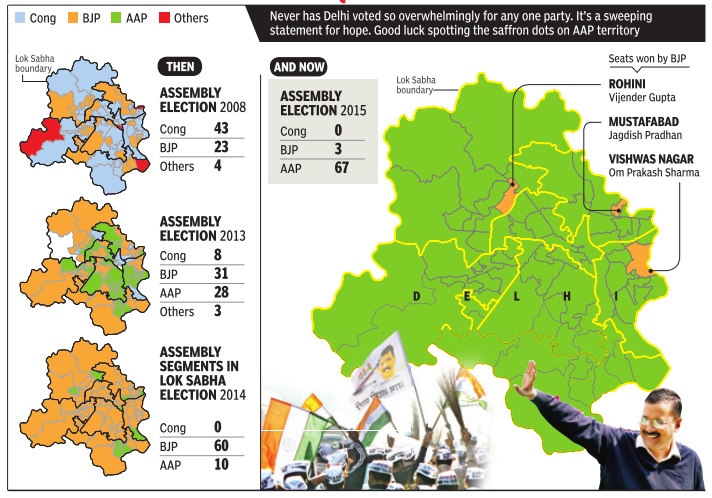
Muslims’ votes
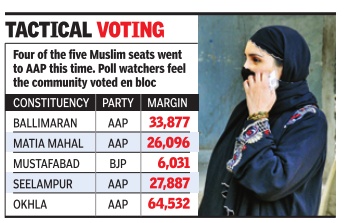
The Times of India Feb 11 2015
Minority report: Cong loses its traditional edge
The community , which had been Congress's face-saver in as many as five seats in the 2013 polls, seems to have abandoned it this time. Not all may have been convinced by AAP's promises, but it seems the community still voted en bloc for it, except in Mustafabad perhaps, where BJP's Jagdish Pradhan won. An AAP supporter reasoned, “Muslims in Mustafabad still voted for Congress, and BJP won only because of the split.“
The seat Congress was sure of winning was Matia Mahal where their candidate, Shoaib Iqbal, had never lost before.“Iqbal could've won on his own but joining Congress was a mistake. Moreover, Muslims this time had made up their mind to vote for AAP ,“ said Babuddin, a cook in the Jama Masjid area.
Corruption, poor living standards and inflation were the deciding factors for Muslim voters, the same as the rest of the city. But a spate of vitriolic speeches raised other con cerns. “There are leaders who keep fanning fear among Muslims. In fact, we are relieved AAP has won, as Congress did very little,“ said Naushad, a Walled City local.
In Okhla, Congress's Asif Mohammed Khan had won with a margin of 28,000 votes in 2013. This time, he finished third with just 20,135 votes.“There is a clear shift this time as our aspirations are the same as that of any other youth,“ said Aseem Ahmed of Zakir Nagar.
Voting pattern in reserved constituencies
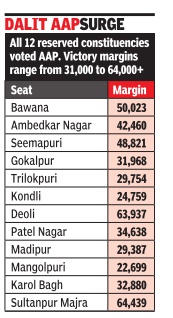
Feb 11 2015
AAP's victory in all 12 reserved seats shows how Arvind Kejriwal had won over Dalits in his 49-day rule with promises of free water, subsidized power and immunity from corruption. Even BJP's last-minute gamble to field Congress's old Dalit face, Krishna Tirath, flopped. He managed around 35,000 votes, less than half that of the AAP victor.“Tirath's gamble didn't work for the BJP and it helped us further,“ said an AAP leader.
Dalits had swung towards AAP in 2013 itself, giving Kejriwal 9 of the 12 seats.It's apparent he consolidated his support in the bastis during his brief rule by checking petty corruption.
BJP's dalit cell head Udit Raj said he had reported to the party brass a week ago that the Dalit vote was slipping from them. “I realized during election campaigning that dalit voters were following AAP ,“ he said. In 2008, nine seats went to Congress, one to BSP and two to BJP .
Many in BJP believe it was the symbol of the broom that worked magic for AAP .
2015: margin of victory
Feb 11 2015
In seat after seat, the gap just got wider
Disproving all assumptions of a close fight between BJP and AAP in most constituencies and triangular contests in many, the results have shown that AAP has not only swept the elections, it has done so comfortably with huge margins in most places. In 2013, the highest margin was over 48,500 while the average margin for all seats was a little under 10,000. In this election, there were seven constituencies which had higher margins than last time’s highest of 48,500 plus. The average margin is about 28,000, almost three times the 2013 average and there are 61 constituencies with higher margins than the 2013 average of almost 10,000.
There were 15 constituencies with margins of over 40,000 votes, all won by AAP.
Another 30 constituencies where margins ranged between 20,000 and 40,000 were also won by AAP. BJP’s first entry into a list of constituencies ranked by descending margin of votes would be at No. 60, indicating that there was a strong wave for AAP not spotted by election analysts or political parties.
AAP’s Mahinder Yadav got the highest margin of 77,665 in Vikaspuri over the BJP candidate. In Okhla, where Congress had won in 2013 with a margin of 26,545 over AAP, this time, AAP’s Amanatullah Khan won with a huge lead of more than 64,000 votes. In Kirari, the constituency with the highest margin in 2013, where BJP candidate Anil Jha had defeated AAP, the party has made an impressive comeback with its candidate Rituraj Govind defeating Jha with a lead of over 45,000 votes.
Interestingly, among the constituencies with the highest margins for AAP this time, six were won by BJP in the last election-Bawana, Matiala, Badarpur, Kirari, Karawal Nagar and Narela. Of the 15 highestmargin seats this time, all won by AAP, only six were won by AAP in 2013. Ironically, the lowest margins too were hogged by AAP. The lowest margin of this election was 1,555 in Najafgarh, where AAP’s Kailash Gahlot defeated the Congress in a nail-biting finish. In 2013 there were five constituencies where the margin was less than 1,000.
The results could have been an even bigger embarrassment for the BJP, which won by relatively narrow margins in two of the three seats they won. These two seats—Rohini and Mustafabad—are among only nine seats which saw margins of less than 10,000. The only seat that BJP retained from the last election was Vishwas Nagar, where Omprakash Sharma won by just over 10,000.


